G2062
Soilborne Root Diseases of Chickpeas in Nebraska
Chickpea crops in Nebraska are susceptible to root diseases. Descriptions and photos showing the effects of specific diseases are provided.
Robert M. Harveson, Extension Plant Pathologist
Introduction
The chickpea (Cicer arietinum L.), also known as the garbanzo bean, is an annual grain legume crop that ranks among the world’s three most important pulse crops (seed legumes used as food). It was one of the first grain legumes domesticated in the Old World and is thought to have originated in present-day southeastern Turkey and northern Syria.
Historically, chickpea has been a minor crop in the United States, but interest in it as an alternative crop to spring cereals has increased in the Pacific Northwest and areas of the High Plains where rainfall is marginal. Production in the western Nebraska Panhandle has fluctuated substantially (1,500 acres in 2000 to almost 10,000 acres in 2006). Several disease problems have been identified in Nebraska that will limit optimal production success if left unchecked. These diseases include Ascochyta blight, caused by A. rabiei (recently the primary cause of substantially reduced acreage), and a root disease complex consisting of several distinct soilborne fungal pathogens. We are currently working to overcome the blight problem with the development of new resistant varieties.
Root Disease Complex
Soilborne fungal pathogens will often act together in complexes rather than as specific diseases, making them difficult to distinguish based on symptoms (Figure 1). Identified members of this complex in Nebraska include Pythium spp., Fusarium solani, Rhizoctonia solani, Fusarium oxysporum, and Phytophthora megasperma. The first three pathogens in this list are much more commonly found in production fields infecting chickpeas, than the latter two.
Each pathogen can cause seed rot, seedling damping-off, or root or stem rot. Members of this complex can reduce emergence or root branching, and collectively can cause both superficial (Figure 2) or sunken lesions (Figure 3) on the root surface that may be either wet or dry in appearance. In general, all pathogens induce aboveground symptoms consisting of wilting and yellowing (Figure 4). Severe economic damage is realized when infection is coupled with some type of stress factor such as drought (Figure 5) or soil compaction (Figure 6).
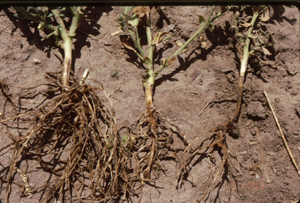 |
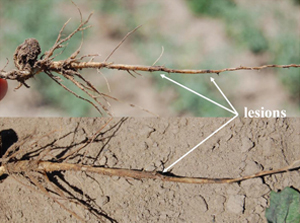 |
|
| Figure 1. Two chickpea plants infected with multiple root pathogen complex on right; note rotted roots, lack of secondary roots, and degree of stunting compared to the uninfected plant on the left. | Figure 2. Young chickpea roots showing individual lesions characteristic of early infection by fungal root pathogens. | |
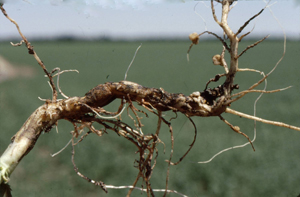 |
 |
|
| Figure 3. Advanced infection showing large craters and necrotic taproot | Figure 4. Foliar symptoms of root rot infection characterized by general chlorosis | |
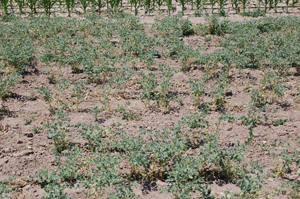 |
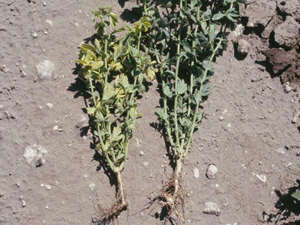 |
|
| Figure 5. Severely stressed chickpea plants in dryland production that are also infected with Fusarium root rot. | Figure 6. Stressed plant on left affected by soil compaction; note stunting, yellowing of foliage and poorly developed root system with main roots growing at a right angle. |
Fusarium Wilt
Cause: (Fusarium oxysporum Schlect. emnd Snyd. and Hans. f. sp. ciceri [Padwick] Snyd. and Hans.)
In many countries where chickpeas are produced, Fusarium wilt is considered to be the most damaging and serious disease other than Ascochyta blight. However, in Nebraska it is occasionally found but is not as problematic as some of the other root diseases discussed later in this publication. This disease is characterized by yellowing (Figure 7) and wilting foliage, which may occur in the seedling stage (Figures 8 and 9) up to the podding stage. Roots of affected plants show no external rotting symptoms, but if sliced open longitudinally, an orange-brown discoloration is observed in vascular tissues (Figure 10). The pathogen survives in soil as thick-walled chlamydospores, or in plant residue. It has been demonstrated to survive in soils for up to five years, but other plant species may also serve as symptomless carriers. Optimal temperature for the fungus to infect roots is approximately 25°C (77°F), and the primary infection occurs via germinating chlamydospores or mycelial fragments.
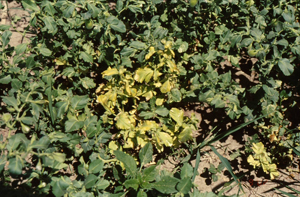 |
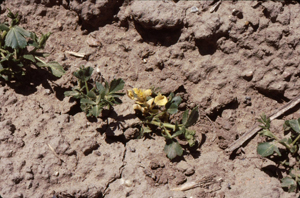 |
|
| Figure 7. Bright yellow foliage characteristic of Fusarium wilt. | Figure 8. Chlorotic leaf symptoms of early seedling infection due to Fusarium wilt | |
 |
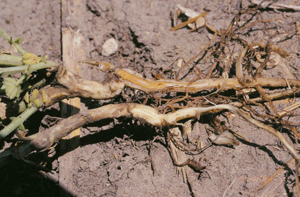 |
|
| Figure 9. On the left, the same seedling from Figure 8 exhibiting vascular discoloration in the seed piece compared to healthy seedling on the right. | Figure 10. Root symptoms of Fusarium wilt showing vascular discoloration with no external rot on plant (top) compared with healthy plant on bottom. |
Rhizoctonia Root Rot
Cause: Rhizoctonia solani Kuhn
Rhizoctonia root rot, also known as wet rot, is commonly found in Nebraska, particularly in irrigated fields. This disease is most commonly seen early in the season when soil moisture content is often high; however, it also can be observed any time during the season. Characteristic symptoms include root rotting, often originating at the distal tip of the young root (Figure 11), and gradual yellowing and wilting of foliage (Figure 12). The rotted, discolored tissues also will be soft and wet (Figure 13).
The fungus survives as sclerotia and as mycelium in infected plant debris or colonized organic matter. Infection originates from these overwintering sclerotia or mycelial fragments. Soil temperatures needed for infection vary between 65° and 85°F, with moderate to high levels of moisture.
Fusarium Root Rot
Cause: (Fusarium solani [Mart.] Appel & Wr.)
Fusarium root rot is also known as black root rot, and is ubiquitously distributed throughout Nebraska production fields due to the fact that it is the same organism that causes Fusarium root rot of dry beans. It is found attacking chickpeas much more commonly than the Fusarium wilt pathogen, and has routinely been the most prevalent chickpea root pathogen in Nebraska under dryland conditions (Figure 14). Plants may exhibit symptoms any time during the season, and affected chickpeas will turn yellow, wilt, and prematurely dry (Figure 5). The root system is rotted with most of the finer roots destroyed, while the taproot remains intact, but dark and necrotic (Figure 15).
This pathogen is similar to F. oxysporum (wilt fungus) by being capable of surviving for many years in soil as chlamydospores. Infection is strongly favored by stress conditions placed on crops.
Pythium Root Rot
Cause: Pythium ultimum Trow and Pythium aphanidermatum Drechs
Pythium is a member of the root disease complex and a major contributor to seed rot and reduction of stands by damping off early in the season at temperatures between 50° and 75°F. P. aphanidermatum also has been found infecting roots later in the season when soil temperatures warm (> 85°F). These infections result in stunted plants with rotted taproots and few viable feeder roots (Figure 16). Both species of Pythium can survive for long periods in soils or plant residues as thick-walled, resistant oospores.
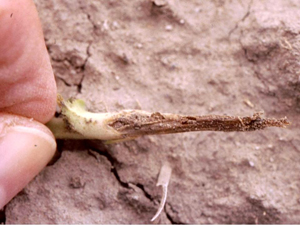 |
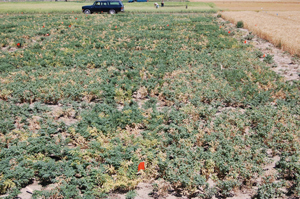 |
|
| Figure 11. Young chickpea root infected with Rhizoctonia solani, causing tip rot. | Figure 12. Severe epidemic of Rhizoctonia root rot; note different degrees of yellowing, wilting, and death of foliage. | |
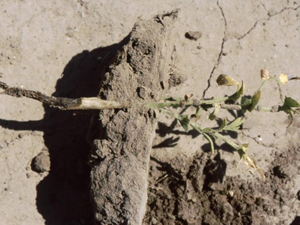 |
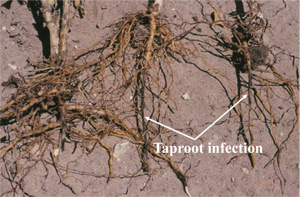 |
|
| Figure 13. Severe tip rot infection due to Rhizoctonia solani, showing the soft, wet rot of taproot. | Figure 14. Chickpea plants infected with Fusarium root rot, under dryland conditions; note the rotted and discolored main taproots. | |
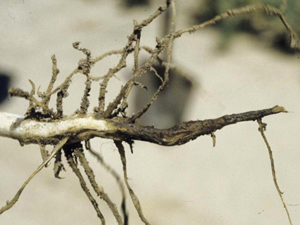 |
 |
|
| Figure 15. Fusarium root rot-infected chickpea plant showing dead, nonfunctional feeder roots with severely rooted taproot. | Figure 16. Young chickpea plants infected by Pythium aphanidermatum; note severely diseased taproot with a lack of secondary feeder roots. |
Phytophthora Root Rot
Cause: (Phytophthora megasperma Drechs)
Phytophthora root and foot rot is not a major yield-limiting disease in Nebraska but has been most commonly observed in chickpea crops following alfalfa. Symptoms consist of stunting and yellowed foliage that dries prematurely coupled with rotted lateral roots and lower portions of the taproot (Figure 17). Rotted areas of the taproot are dark brown to black (Figure 18) and may be easily confused with wet rot (Rhizoctonia root rot) or black rot (Fusarium root rot). Disease is favored by warm (85°-90°F) and near saturated soils.
Management (applies to all diseases)
- Plant certified, disease-free seed.
- Treat seed or furrow with registered fungicides to protect seedlings.
- Where possible, avoid stresses on plants by alleviating soil compaction, ensuring proper fertility, and maintaining proper irrigation levels.
- Use resistant cultivars if available.
- Do not plant chickpeas following another pulse or legume crop.
- Avoid planting in poorly drained or highly acidic soils (pH < 6.5).
- Closely watch crop and treat with fungicides, if needed, to manage Ascochyta blight, which can predispose the plant to subsequent root rot infection.
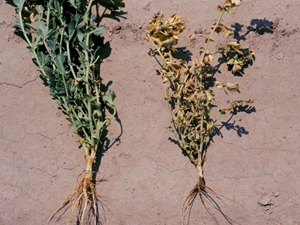 |
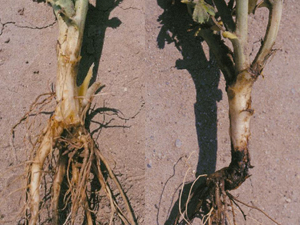 |
|
| Figure 17. Plant infected by Phytophthora root rot (right). Note overall stunting and yellowing of affected plant compared to uninfected plant on left. | Figure 18. Same two plants from Figure 17 showing close-up of dark, necrotic roots of infected root on right. |
This publication has been peer reviewed.
Visit the University of Nebraska–Lincoln Extension Publications Web site for more publications.
Index: Plant Diseases
Specialty Crops
Issued May 2011